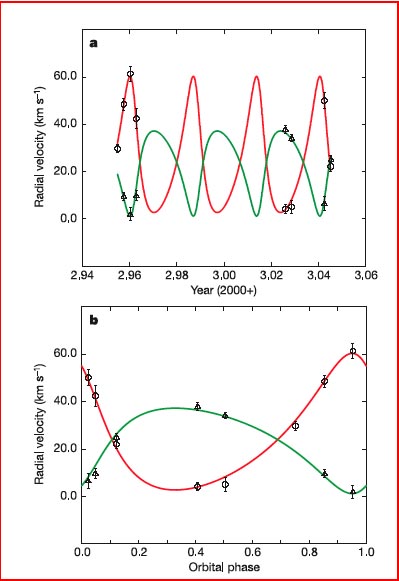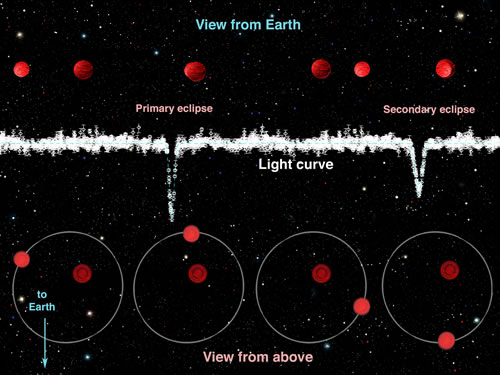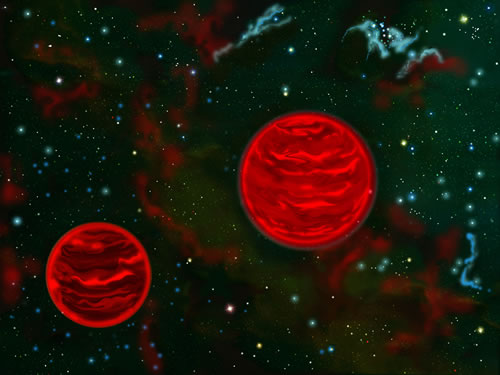
Figure 1. Radial velocity measurements and orbit solution. These plots are based on high-resolution, near-infrared spectra of 2MASS J05352184–0546085 with the PHOENIX spectrograph (resolving power of 30,000) at the 8-meter Gemini South telescope on eight separate nights from December 2002 to January 2003. A cross-correlation analysis of the individual spectra against a radial velocity standard star yields the radial velocities of the two components at eight distinct orbital phases. The team tried several different radial velocity standard stars with spectral types M1to M9, and found that an M6.5 star produced the strongest cross-correlation signals for both components; the spectra of the two components are therefore probably similar to that of an M6.5 spectral type. Here the individual, heliocentric radial velocity measurements of the components of 2MASS J05352184–0546085 are shown, as functions of both time (a) and orbital phase (b). Orbital phase is measured with respect to the time of periastron passage (that is, closest approach of the two brown dwarfs to one another), as determined from the final orbit solution. Measurements of the primary are represented as triangles; the secondary as circles. The typical uncertainty on the radial velocity measurements is 2 kilometers/second. The final orbit solution was determined by simultaneously fitting the light-curve and radial velocity measurements using a standard detached-eclipsing-binary model. This orbit solution is shown in a and b as solid curves, green for the more massive component, red for the less massive component. The reduced chi-squared of the fit is 1.0.

Figure 2. The light coming from the pair of brown dwarfs dips periodically when their orbit causes one to pass in front of the other from our perspective on the Earth. During these brief periods the nearer brown dwarf blocks the light from the further dwarf causing the total amount of light coming from the pair to drop by about half.
Credit: Gemini Observatory/Jon Lomberg Illustration

Figure 3. Artist's rendering of the binary dwarf pair as viewed in infrared light.
Credit: Gemini Observatory/Jon Lomberg Illustration
A U.S.-led team of astronomers, led by Keivan Stassun of Vanderbilt University, has used Gemini South's high-resolution infrared spectrograph PHOENIX to uncover the dynamics of the eclipsing brown dwarf pair 2MASS J0532184-0546085. The observations of the pair, in the Orion Nebula, complemented data from the 0.9-meter telescope at Kitt Peak and the 0.9-meter, 1.0-meter and 1.3-meter telescopes at the Cerro Tololo Inter-American Observatory.
The findings show that the radii of the failed stars are quite large (as models predict), but that the least massive of the pair is hotter than the larger partner. The temperature observations are contrary to expectations.
The Gemini data consists of a suite of high-resolution spectra made from eight observations between December 2002 and January 2003. This allowed the team to sample the velocities of the two objects throughout their entire orbital phase.
This is the first direct, accurate measurements of the physical properties of young brown dwarfs. By measuring the radii, masses and luminosities Stassun et al. have provided a unique and fundamental contribution to our understanding of brown dwarfs.
The data sets have a spectral resolution of ~30,000, which allowed the team to measure the radial velocity (motion toward or away from us) of both brown dwarfs down to +/- 2 kilometers per second. The observations furnished a key piece of information that, when added to the light curve measurements from the other telescopes, gave the team members what they needed to determine the final orbital solution of the system.
The result appears in the March 16th, 2006 issue of Nature and is featured in a press release from Vanderbilt University (requires FLASH® plug-in). The team included Robert Mathieu of the University of Wisconsin-Madison and Jeff Valenti of the Space Telescope Science Institute.